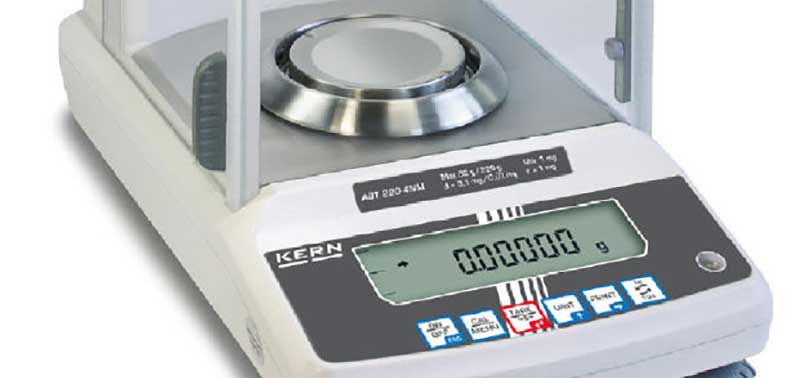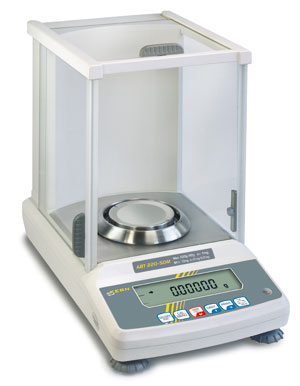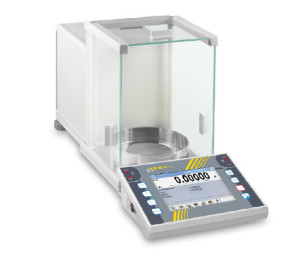
How to Use an Analytical Balance: 5 Tips
University and industrial laboratory researchers requiring extremely accurate measurements of extremely small quantities rely on a precision instrument called an analytical balance. Shopping for an analytical balance requires being familiar with some of the advanced features available today as well as the proper use of these precision instruments. It is on the second point that we focus this post on how to use an analytical balance.
Here you will learn
- How to set up an analytical balance
- The effect of environment on weighing accuracy
- How samples can introduce errors
- The importance of personal practices
- Important maintenance tips
A Brief Introduction to Analytical Balances
A milligram analytical balance such as the Kern digital scale models available from Tovatech are among the most sensitive instruments in your laboratory.
In order to comply with good manufacturing practices (GMP) and good laboratory practices (GLP) lab personnel must follow specific procedures to ensure weighing accuracy.
Recommend procedures are generally spelled out in analytical balance operations manuals. Because these brochures go into detail on all aspects of using an analytical balance we offer this brief as a ready reference for new lab personnel and as a reference for the seasoned pro.
Our post closes with a list of features and functions offered on select analytical balances offered by Tovatech and a link to other useful blog posts on the topic.
Using Analytical Balances – 5 Tips
Tip No. 1: Start Right with Calibration
Folks may be surprised to learn that gravitational pull varies from place to place throughout the world. This was amusingly demonstrated by a recent experiment involving the well-travelled Kern Gnome.
Therefore, when using an analytical balance
- It must be calibrated at the location where it will be used.
- It must be re-calibrated any time it is moved and
- It should be re-calibrated on a regular basis.
Some balances are internally calibrated, others externally calibrated. User manuals provide instructions.
For additional information we direct you to our post on calibration weights used for an externally calibrated analytical balance.
Tip No. 2: An Analytical Balance is Sensitive
It does not take much to throw a milligram balance off so they must be positioned levelly on a vibration-free worktable.
Most analytical balances are equipped with leveling bubbles; vibrations can come from a variety of sources but most likely passing foot traffic in the lab.
Weighing tables are available to absorb vibrations and oscillations that otherwise distort weighing results.
Analytical balances don’t like temperature fluctuations, humidity fluctuations and breezes. Shield them from direct sunlight and site them away from HVAC vents.
Even the slightest flow of air can throw off a weighing operation, which is why weighing pans are enclosed in movable doors that must be closed after the sample is placed and before weighing begins.
Tip No. 3: Sample-Induced Errors
Non-conductive samples such as plastics, china and glass may carry an electrostatic charge that can distort weighing results.
This situation can be avoided by an ionizer to neutralize electrostatic charge. For a closer look at this see our link below under Useful Analytical Balance Accessories. Samples being weighed should be at room temperature to avoid air currents inside the enclosure.
Tip No. 4: Wear Gloves
Don’t throw off the tare of sample pans by touching them with your bare fingers. That is because oil on your fingers will lead to an incorrect reading.
Instead you should use gloves or pan holders. This same caution applies to handing test weights for manually calibrated analytical balances. Gloves or tweezers should be used. See our post discussing calibrating and test weights for more information.
Tip No. 5: Keep it Clean
Operating manuals shipped with analytical balances provide instruction on cleaning these precision instruments.
First we suggest you remove loose samples with a soft brush or a gentle vacuuming. Follow instructions on removing and cleaning the doors enclosing the weighing area.
After this, remember that aggressive cleaning agents such as solvents should not be used. Instead use a cloth dampened with mild soap suds. Take care that liquid does not spill into the device, then polish it with a dry soft cloth.
Servicing an analytical balance should only be done by trained technicians authorized by the manufacturer.
Useful Accessories and Select Features/Functions for your Analytical Balance
A useful accessory for an analytical balance is an electrostatic discharge ionizer, especially when weighing grams and milligrams of non-conductive materials such as plastic, china and glass.
Because these and other products may carry an electrostatic charge an electromagnetic field can be generated between the materials being weighed and the analytical balance itself. This can dramatically impact accuracy.
The ionizers can be mounted next to the balance or be manually directed from all sides toward the sample being weighed. A simple precaution such as this can greatly improve the accuracy of your operations.
Another accessory that may be useful is for density determination of liquids and solids.
Analytic Balance Select Features and Functions
Depending on models a variety of features and functions are available on today’s precision analytical balances. Examples include
- piece counting
- tolerance weighing (determine % deviation of a sample from a reference weight)
- recipe weighing
- weighing unstable samples
- GLP/ISO record-keeping capability
- underside (suspended) weighing
- user-selectable weighing units (metric and non-metric)
- WLAN connectivity
Need more Analytical Balance Info?
For more information on selecting and using analytical balances please check our blog posts on this topic. For help in selecting and using a unit that meets your requirements call or chat with us.


